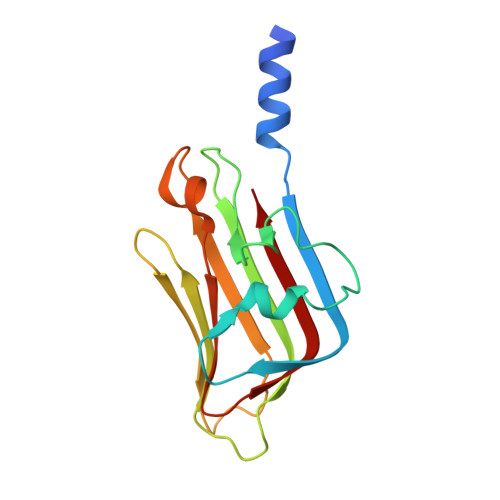The tip of the tail needle affects the rate of DNA delivery by bacteriophage p22.
Leavitt, J.C., Gogokhia, L., Gilcrease, E.B., Bhardwaj, A., Cingolani, G., Casjens, S.R.(2013) PLoS One 8: e70936-e70936
- PubMed: 23951045
- DOI: https://doi.org/10.1371/journal.pone.0070936
- Primary Citation of Related Structures:
4K6B - PubMed Abstract:
The P22-like bacteriophages have short tails. Their virions bind to their polysaccharide receptors through six trimeric tailspike proteins that surround the tail tip. These short tails also have a trimeric needle protein that extends beyond the tailspikes from the center of the tail tip, in a position that suggests that it should make first contact with the host's outer membrane during the infection process. The base of the needle serves as a plug that keeps the DNA in the virion, but role of the needle during adsorption and DNA injection is not well understood. Among the P22-like phages are needle types with two completely different C-terminal distal tip domains. In the phage Sf6-type needle, unlike the other P22-type needle, the distal tip folds into a "knob" with a TNF-like fold, similar to the fiber knobs of bacteriophage PRD1 and Adenovirus. The phage HS1 knob is very similar to that of Sf6, and we report here its crystal structure which, like the Sf6 knob, contains three bound L-glutamate molecules. A chimeric P22 phage with a tail needle that contains the HS1 terminal knob efficiently infects the P22 host, Salmonella enterica, suggesting the knob does not confer host specificity. Likewise, mutations that should abrogate the binding of L-glutamate to the needle do not appear to affect virion function, but several different other genetic changes to the tip of the needle slow down potassium release from the host during infection. These findings suggest that the needle plays a role in phage P22 DNA delivery by controlling the kinetics of DNA ejection into the host.
Organizational Affiliation:
Biology Department, University of Utah, Salt Lake City, Utah, USA.
















